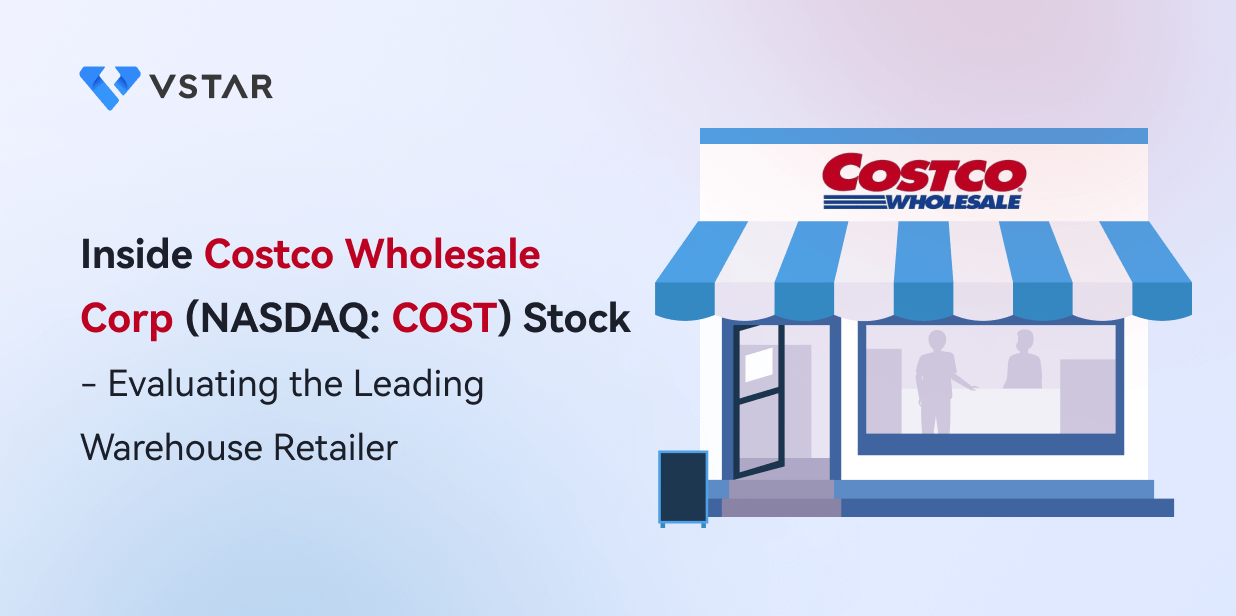Costco Wholesale Corp (NASDAQ: COST) is one of the largest and most successful retailers in the world, with over 800 warehouses in 13 countries and more than 100 million members. The company offers a wide range of products and services to its members, including groceries, electronics, home furnishings, pharmacy, optical, travel, and gas. Costco is known for its low prices, high-quality merchandise, and loyal customer base.
Costco Wholesale Corp's Overview
Costco Wholesale Corp is a leading American retailer that operates a chain of warehouse clubs where members can buy a wide range of products at low prices. Costco got founded in 1983 by James Sinegal and Jeffrey Brotman, who opened the first warehouse in Seattle, Washington.
Costco's current company structure comprises three geographical segments: the United States, Canada, and Other International Operations. The company also operates several subsidiaries, such as Costco Wholesale Industries, Costco Travel, and Costco Online. The company's CEO and director is Walter Craig Jelinek, who joined Costco in 1984 and became the chief executive in 2012. Some of the top shareholders and investors of Costco include The Vanguard Group, BlackRock, Berkshire Hathaway, State Street Corporation, and Capital Research and Management Company.
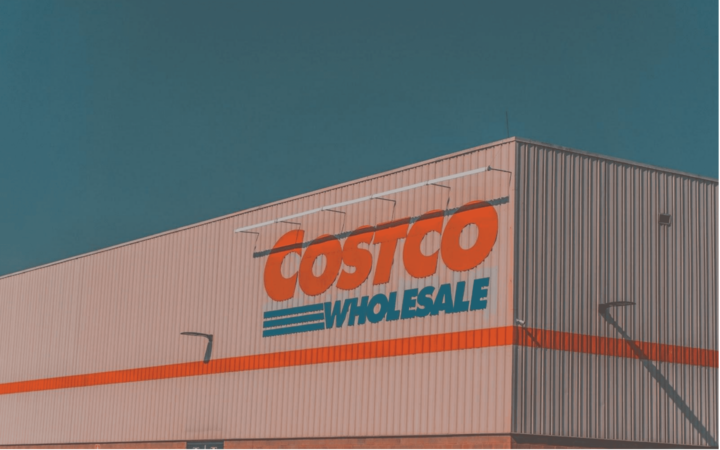
Source: Unsplash
Some of the key milestones in Costco's history are:
- In 1993, Costco merged with Price Club, another warehouse club chain founded by Sol Price in 1976, to form Price/Costco.
- In 1997, the company changed its name to Costco Companies, Inc., and rebranded all its warehouses as Costco.
- In 1999, the company adopted its current name, Costco Wholesale Corporation, and launched its e-commerce website, Costco.com.
- In 2001, Costco introduced its private label brand, Kirkland Signature, which offers high-quality products at lower prices than national brands.
- In 2009, Costco became the first U.S. retailer to sell more than one billion gallons of gasoline in a year.
- In 2012, Costco opened its first warehouse in China, in Shanghai.
- In 2019, Costco opened its first warehouse in Iceland, in Reykjavik.
Costco Wholesale Corp's Business Model and Products/Services
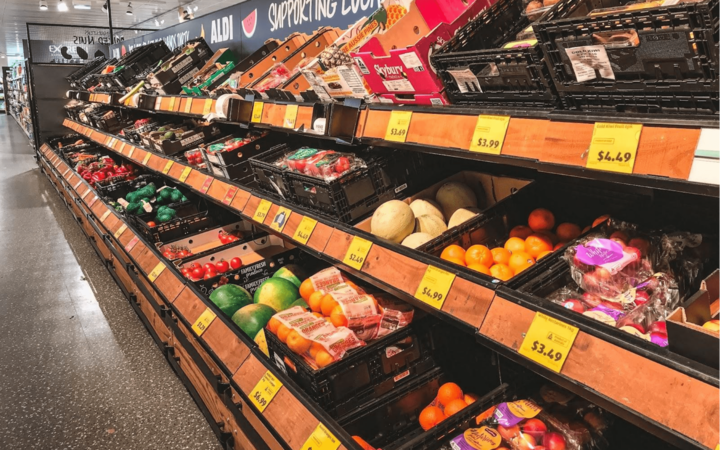
Source: Unsplash
Costco's business model has its basis on two primary sources of revenue: merchandise sales and membership fees. Merchandise sales account for the majority of Costco's revenue, as the company sells a wide range of products and services at low prices to its members. Costco operates on a low-profit margin strategy, charging a small product markup, usually around 12% or less. This allows Costco to offer competitive prices and attract more customers, who then buy more items in bulk. Costco also benefits from economies of scale, as it purchases large quantities of goods from suppliers at discounted prices and passes the savings on to its members.
Membership fees are another vital source of revenue for Costco, as they provide a steady and recurring income stream for the company. Costco offers three types of memberships: Gold Star, Business, and Executive. Gold Star and Business memberships cost $60 per year, while Executive memberships cost $120 per year. Executive members enjoy additional benefits, such as 2% cash back on most purchases, travel discounts, and other perks. Membership fees help Costco cover its operating costs, such as rent, utilities, wages, and taxes. They also create customer loyalty, as members are more likely to shop at Costco than at other retailers.
Main Products and Services
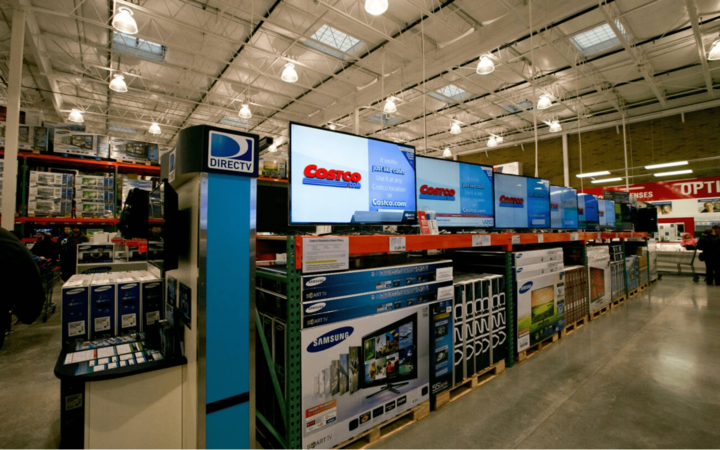
Source: Alamy
Costco's main products and services can get categorized into three segments:
- Foods and sundries
- Hardlines
- Fresh foods
Foods and sundries include dry groceries, candy, snacks, beverages, tobacco, health and beauty aids, cleaning supplies, paper products, and pet food. Hardlines include major appliances, electronics, computers, furniture, mattresses, jewelry, sporting goods, toys, hardware, automotive care, tires, and optical services. Fresh foods include meat, produce, bakery, deli, seafood, and floral products. Costco also offers ancillary services, such as gas stations, pharmacies, food courts, hearing aid centers, photo centers, travel services, car rentals, car sales, home installation services, business delivery services, and e-commerce platforms.
Costco Wholesale Corp's Financials, Growth, and Valuation Metrics
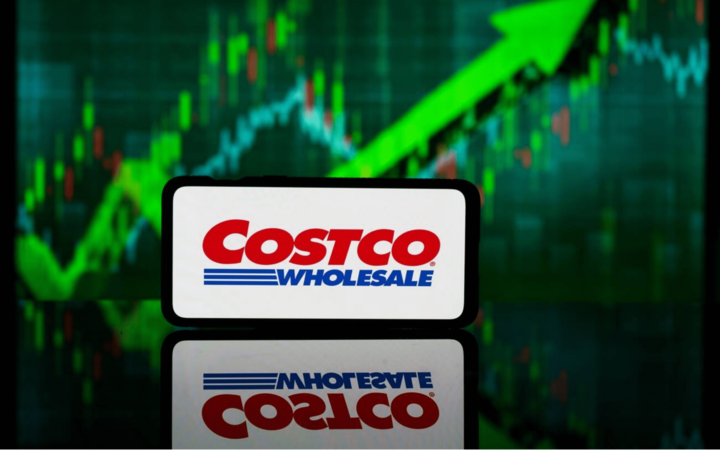
Source: Alamy
Costco Wholesale Corp's recent financial statement provides insights into its financial performance and position. As of May 25, 2023, the company's market capitalization reached $189.8 billion, establishing it as the third-largest global retailer, following Amazon and Walmart. In the third quarter of fiscal 2023, Costco reported a net income of $1.22 billion, showing a 1.4% decrease from the prior year, driven by elevated operating expenses and reduced interest income. Meanwhile, the quarter's revenue growth was 2%, reaching $53.65 billion, attributed to strong comparable sales in regions like the U.S., Canada, and Mexico. Despite a slightly lower profit margin of 2.3% compared to the previous year's 2.4%, Costco's return on equity increased slightly to 21.7%, reflecting higher net income and lower average equity.
The balance sheet remains robust, with $13.9 billion in cash, $9 billion in long-term debt, and $23.6 billion in total equity. A current ratio of 1.1 indicates adequate short-term obligation coverage, and a debt-to-equity ratio of 0.38 signifies moderate debt relative to equity. The company's third-quarter free cash flow of $1.8 billion demonstrates its capacity to cover operational and investing activities, contributing to its overall financial stability.
Key Financial Ratios and Metrics
Costco's valuation multiples, including the price-to-earnings (P/E), price-to-sales (P/S), price-to-book (P/B), and enterprise value-to-EBITDA (EV/EBITDA) ratios, provide insights into its stock's relative positioning. As of May 25, 2023, these metrics reveal distinctive trends. The P/E ratio, standing at 40.5, surpasses its peers and industry averages (28.9 and 27.5, respectively), indicating a premium tied to earnings. In contrast, the P/S ratio of 0.9 indicates a discount compared to peers (1.1) and the industry (1), reflecting a relative decrease in sales. Similarly, the P/B ratio at 8 is higher than peers' (6.4) and industry (5) averages, signaling an elevated valuation relative to book value. Moreover, the EV/EBITDA ratio of 18 exceeds peers' (14.8) and industry (13) averages, denoting a premium regarding EBITDA.
These figures imply an overvaluation of Costco's stock relative to its peers and the industry, highlighting optimistic market expectations for its future growth and profitability. However, varying investor perspectives and considerations of Costco's robust competitive standing, devoted customer base, consistent revenue expansion, and solid financial foundation may provide arguments for a higher valuation.
Costco Stock Performance Analysis
Costco Wholesale Corp, founded in 1983 and publicly listed on the Nasdaq Global Select Market under the ticker symbol COST in 1985, operates primarily in U.S. dollars. Regular trading occurs from 9:30 a.m. to 4:00 p.m. Eastern Time (ET) on weekdays, supplemented by pre-market and after-market sessions from 4:00 a.m. to 9:30 a.m. ET and 4:00 p.m. to 8:00 p.m. ET, respectively. Costco has split its stock three times over its nearly four decades as a public company, with the most recent being a 2-for-1 split in 2015.
Costco Dividend
Costco has consistently paid dividends to shareholders since 2004, with the latest being $1.02 per share on May 5, 2023.
Costco's stock price trajectory since its IPO illustrates its robust growth and profitability. Reaching an all-time high of $571.16 on July 27, 2023, the stock experienced an exceptional surge of over 5,000% from its $10 IPO price. As of August 10, 2023, the stock's value was $561.49, a 1.69% decrease from its peak but a 23.87% year-to-date increase. This performance reflects multiple factors, including earnings reports, market dynamics, competition, consumer trends, and broader economic influences. Despite these fluctuations, Costco stock has demonstrated relatively low volatility compared to its peers, with a beta of 0.79 as of August 9, 2023, indicating less sensitivity to market fluctuations.
Driving Costco stock performance are elements like costco news, revenue growth, margin expansion, membership engagement, e-commerce advancement, international expansion, capital management, and competitive strengths.
Costco Stock Price Forecast
Costco stock has been on a strong uptrend since March 2020, when it hit a low of $271.28 amid the Covid-19 pandemic. Since then, the stock has rallied more than 100% to reach its current value. The stock has been trading above its 50-day and 200-day moving averages, indicating a positive momentum. The stock has also broken out of a symmetrical triangle pattern on the daily chart, which suggests a continuation of the uptrend.
● Key Resistance and Support Levels of Costco Stock
According to the TradingView chart below, Costco stock has some key resistance and support levels that may be potential targets or obstacles for its price movement. The resistance levels depend on the Fibonacci extensions of the previous swing, high and low, while the support levels depend on the Fibonacci retracements of the same swing. The nearest resistance level for Costco stock is $582.23, which is the 161.8% Fibonacci extension of the swing from $517.11 to $495.18.
If the stock can break above this level, it may target the next resistance at $602.51, the 200% Fibonacci extension. The nearest support level for Costco stock is at $540.64, which is the 23.6% Fibonacci retracement of the swing from $495.18 to $557.95. If the stock can hold above this level, it may return to the upside. However, if the stock breaks below this level, it may test the next support at $525.14, the 38.2% Fibonacci retracement.
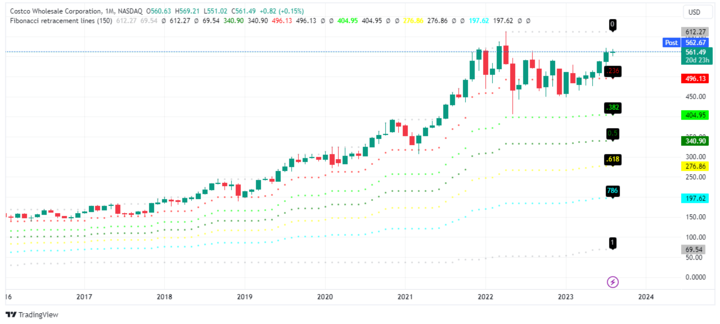
Source: TradingView
● Analyst Recommendations and COST Stock Price Targets
According to TipRanks, Costco stock has a strong buy rating based on 17 analyst ratings. The average price target for Costco stock is $614.06, which implies a 9.66% upside potential from its current price of $559.99 (as of August 10, 2021). The highest price target for Costco stock is $650, while the lowest is $500.
Some of the major analysts who have issued bullish price targets for Costco stock are:
- Telsey Advisory Group: $650 (16% upside potential)
- Oppenheimer: $625 (11.6% upside potential)
- Raymond James: $620 (10.7% upside potential)
- Morgan Stanley: $615 (9.8% upside potential)
- Wells Fargo: $610 (8.9% upside potential)
In conclusion, Costco stock seems to have a positive outlook for the future based on its strong fundamentals, technicals, and analyst opinions. However, investors should also be aware of the potential risks and challenges that may affect its performance, such as competition, inflation, supply chain disruptions, and regulatory changes.
Challenges and Opportunities
Costco Wholesale Corp faces various challenges and prospects that shape its trajectory within the retail sector. Key factors influencing the company's performance include competitive dynamics and growth drivers:
- Competitive Landscape: Costco operates in a highly competitive retail environment, facing pressure from formidable competitors like Walmart, Amazon, Target, and others. Walmart's global retail presence and robust online platforms, along with Amazon's e-commerce dominance and physical expansion through acquisitions like Whole Foods, pose substantial challenges.
- Risks Overview: Beyond competition, Costco faces risks such as supply chain disruptions due to factors like pandemics and trade tensions. Regulatory compliance complexities across multiple jurisdictions and cybersecurity vulnerabilities are additional threats. Unauthorized data breaches could lead to significant operational disruptions, legal repercussions, and reputational damage.
- Growth Potential: Amid these challenges, Costco holds key growth opportunities. The company's e-commerce sales surged significantly. Enhanced online offerings, including grocery delivery, prescription services, and curbside pickup, could further expand its reach and enhance customer loyalty. International expansion remains a focal point, allowing Costco to tap into diverse markets and capitalize on favorable economic trends. The company's product innovation efforts, particularly its highly successful private label brand, Kirkland Signature, position it to cater to evolving customer preferences, as evidenced by recent ventures into plant-based offerings.
- Outlook and Expansion: While Costco anticipates near-term challenges like inflation and supply chain disruptions, its growth strategy remains promising. In the upcoming fiscal year, the company is set to open 25 new warehouses, 12 in the U.S. and 13 internationally. Additionally, a 10% increase in capital expenditures gets allocated for various endeavors, including warehouse expansion and technology upgrades. Despite these immediate headwinds, Costco's robust competitive stance, backed by a steadfast membership base, should sustain long-term growth momentum.
In navigating these intricate dynamics, Costco strives to leverage its strengths and mitigate risks, poised to carve a steadfast path in the competitive retail landscape.
Why Traders Should Consider Costco Stock
Costco is a well-established and profitable company that consistently delivers strong financial results and shareholder value. The company has a loyal customer base, a diversified product mix, a low-cost business model, and a global expansion strategy. Costco also benefits from its membership fees, which provide a stable and recurring source of revenue.
Traders interested in Costco stock can use various strategies to capitalize on its price movements. One of the most popular and flexible ways to trade Costco stock is through CFDs (contracts for difference). CFDs are derivative instruments that allow traders to speculate on the price changes of an underlying asset without owning it. CFDs have several advantages over traditional stock trading, such as:
- Access to leverage: CFDs enable traders to use leverage, which means they can trade with more money than they have in their account. This can magnify profits and losses, so traders should be careful and use risk management tools.
- Ability to go long or short: CFDs allow traders to profit from rising and falling markets by opening long (buy) or short (sell) positions. For example, if a trader thinks that Costco stock will increase in value, they can open a long CFD position and close it at a higher price later. Conversely, if a trader expects Costco stock to decline in value, they can open a short CFD position and close it at a lower price later.
- No commissions or fees: CFDs get traded on margin, meaning traders only pay the spread (the difference between the bid and ask prices) when they enter and exit a trade. There are no commissions or fees involved in CFD trading, unlike stock trading, which can incur brokerage charges and taxes.
- Access to global markets: CFDs allow traders to access a wide range of markets and assets from one platform, including stocks, forex, commodities, indices, and cryptocurrencies. Traders can diversify their portfolios and exploit market opportunities across regions and sectors.
Trading Strategies for Costco Stock
Many trading strategies can get applied to Costco stock CFDs, depending on the trader’s goals, risk appetite, and time horizon. Some of the common trading strategies are:
- Trend following
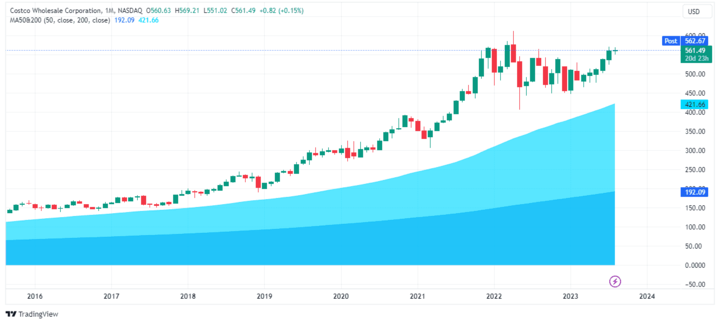
Source: TradingView
This strategy involves identifying the direction and strength of the market trend and following it until it reverses. Traders can use technical indicators such as moving averages, trend lines, and chart patterns to determine the trend and entry and exit points. For example, a trader can use a simple moving average crossover system to trade Costco stock CFDs. A buy signal gets generated when the short-term moving average crosses above the long-term moving average, indicating an uptrend. A sell signal gets generated when the short-term moving average crosses below the long-term moving average, indicating a downtrend.
- Swing trading
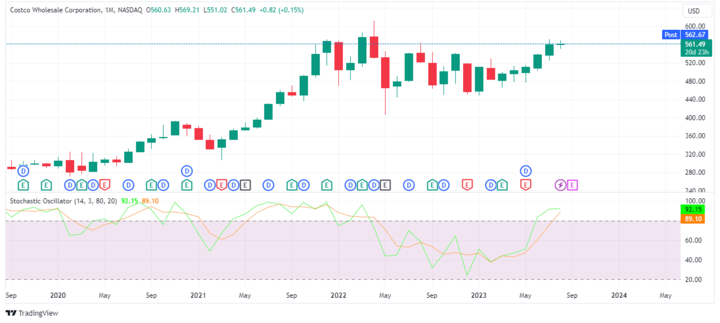
Source: TradingView
This strategy involves capturing short-term price movements within a larger trend. Traders can use technical analysis tools such as support and resistance levels, Fibonacci retracements, and oscillators to identify potential swing points and trade signals. For example, a trader can use the stochastic oscillator to trade Costco stock CFDs. The stochastic oscillator measures the momentum of the price movements and shows overbought and oversold conditions. A buy
When the oscillator crosses above 20 from below, indicating an oversold condition and a possible reversal, a buy signal gets generated. Also, when the oscillator crosses below 80 from above, indicating an overbought condition and a possible reversal, a sell signal gets generated.
- Scalping
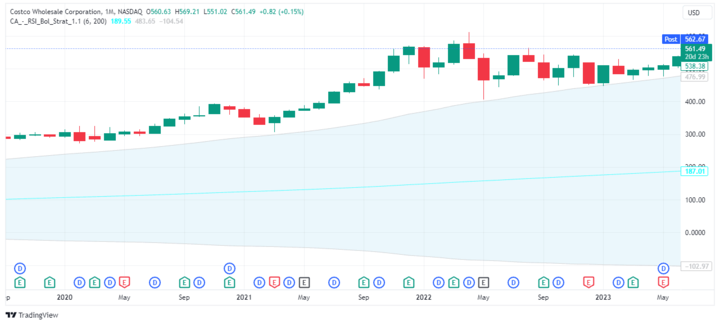
Source: TradingView
This strategy involves taking small profits from frequent trades within a short time frame, usually minutes or hours. Traders can use technical analysis tools such as candlestick patterns, Bollinger bands, and RSI to identify price fluctuations and trade opportunities. For example, a trader can use Bollinger bands to scalp Costco stock CFDs. Bollinger bands consist of a middle band (a simple moving average) and two outer bands (standard deviations above and below the middle band). The bands indicate the volatility of the price movements and potential breakout points. A buy signal gets generated when the price touches the lower band and rebounds, indicating an oversold condition and a possible bounce. A sell signal gets generated when the price touches the upper band and retreats, indicating an overbought condition and a possible pullback.
Trade Costco Stock CFD with VSTAR
VSTAR is a reputable online trading platform offering access to a diverse range of financial instruments, including stocks, forex, commodities, indices, and cryptocurrencies. It stands out with competitive spreads and zero commissions. VSTAR guarantees swift execution using advanced technology, ensuring minimal latency, no requotes, and no slippage.
With VSTAR, you can utilize leverage ratios of up to 1:200, alongside comprehensive customer support available 24/7 via phone, email, live chat, and social media, ensuring a well-rounded trading experience.


Conclusion
Costco is a leading warehouse retailer with strong financial performance and a loyal customer base. The company has a competitive advantage over its rivals due to its low-cost business model, diversified product mix, global expansion strategy, and membership fees. Traders interested in Costco stock can use CFDs to speculate on its price movements without owning the underlying asset. CFDs offer several benefits over traditional stock trading, such as access to leverage, the ability to go long or short, no commissions or fees, and access to global markets. However, CFDs also involve risks, such as market volatility, margin calls, overnight charges, and counterparty risk. Therefore, traders should be careful and use risk management tools when trading CFDs. If you want to start trading Costco stock CFDs with VSTAR, you can open an account today.







